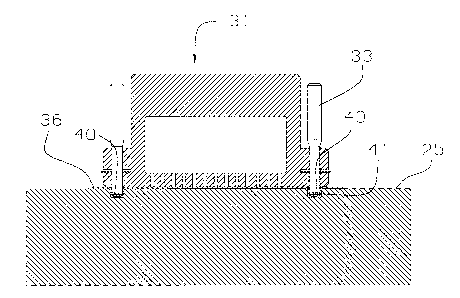Some of the information on this Web page has been provided by external sources. The Government of Canada is not responsible for the accuracy, reliability or currency of the information supplied by external sources. Users wishing to rely upon this information should consult directly with the source of the information. Content provided by external sources is not subject to official languages, privacy and accessibility requirements.
Any discrepancies in the text and image of the Claims and Abstract are due to differing posting times. Text of the Claims and Abstract are posted:
| (12) Patent Application: | (11) CA 2334682 |
|---|---|
| (54) English Title: | METHOD AND APPARATUS FOR FASTENING IDENTIFICATION LABELS TO WOOD PRODUCTS |
| (54) French Title: | METHODE ET APPAREIL POUR LA FIXATION DES ETIQUETTES D'IDENTIFICATION SUR LES PRODUITS EN BOIS |
| Status: | Withdrawn |
| (51) International Patent Classification (IPC): |
|
|---|---|
| (72) Inventors : |
|
| (73) Owners : |
|
| (71) Applicants : |
|
| (74) Agent: | |
| (74) Associate agent: | |
| (45) Issued: | |
| (22) Filed Date: | 2001-03-02 |
| (41) Open to Public Inspection: | 2002-09-02 |
| Availability of licence: | N/A |
| Dedicated to the Public: | N/A |
| (25) Language of filing: | English |
| Patent Cooperation Treaty (PCT): | No |
|---|
| (30) Application Priority Data: | None |
|---|
A method and apparatus are disclosed for applying identification labels on
wooden products. A fastening system where a plastic label marked by a bar code
or other
identification method is picked up by vacuum onto the applicator tool which
will insert
forcibly edges of the identification label into the wooden product to remain
permanently
wedged in the indentation. During subsequent cutting of the wooden product
into which
is attached identification plastic label there will be no danger from
dislodged or
fragmented metal staples as is presently the case.
Another method is described where soft pliable plastic identification label is
being
picked up by the vacuum onto the applicator apparatus which is equipped with
punches
that will punch strips of hard plastic and push cut disks from the hard
plastic over the soft
pliable plastic label into the wooden product. Hard plastic disks will remain
permanently
wedged into the formed hole and secure the soft pliable plastic label to the
wooden
product. During subsequent cutting of the wood when the label is cut it will
not present
danger to the operator or the bystanders.
Note: Claims are shown in the official language in which they were submitted.
Sorry, the claims for patent document number 2334682 were not found.
Text is not available for all patent documents. The current dates of coverage are on the
Currency of Information
page
Note: Descriptions are shown in the official language in which they were submitted.

2024-08-01:As part of the Next Generation Patents (NGP) transition, the Canadian Patents Database (CPD) now contains a more detailed Event History, which replicates the Event Log of our new back-office solution.
Please note that "Inactive:" events refers to events no longer in use in our new back-office solution.
For a clearer understanding of the status of the application/patent presented on this page, the site Disclaimer , as well as the definitions for Patent , Event History , Maintenance Fee and Payment History should be consulted.
| Description | Date |
|---|---|
| Change of Address Requirements Determined Compliant | 2002-10-15 |
| Inactive: Office letter | 2002-10-15 |
| Inactive: Office letter | 2002-10-15 |
| Inactive: Withdraw application | 2002-09-12 |
| Inactive: Correspondence - Formalities | 2002-09-12 |
| Change of Address or Method of Correspondence Request Received | 2002-09-12 |
| Inactive: Withdraw application | 2002-09-12 |
| Application Published (Open to Public Inspection) | 2002-09-02 |
| Inactive: Cover page published | 2002-09-01 |
| Inactive: Incomplete | 2002-08-13 |
| Inactive: First IPC assigned | 2001-03-23 |
| Inactive: Filing certificate - No RFE (English) | 2001-03-09 |
| Filing Requirements Determined Compliant | 2001-03-09 |
| Application Received - Regular National | 2001-03-08 |
There is no abandonment history.
| Fee Type | Anniversary Year | Due Date | Paid Date |
|---|---|---|---|
| Application fee - small | 2001-03-02 |
Note: Records showing the ownership history in alphabetical order.
| Current Owners on Record |
|---|
| MIROSLAV HARCUBA |
| Past Owners on Record |
|---|
| None |